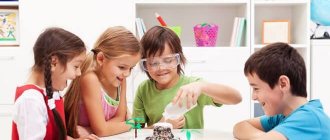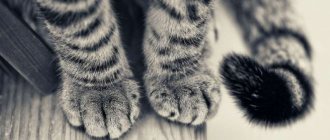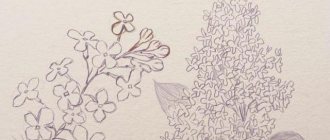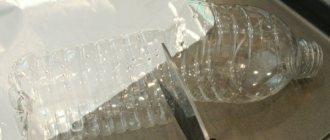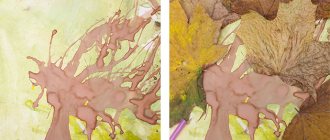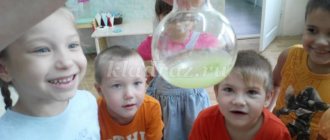Theme: “Journey to the City of Masters”
Goal: Continue to develop interest in people, consolidate children’s knowledge about the senses, their role in a person’s perception of the world around them.
Tasks:
Correctional and educational:
- generalize children’s existing knowledge about the functions of the senses;
- clarify the meaning of the senses for a person when he perceives the world around him;
- develop the ability to analyze data obtained through experimentation;
- discuss issues of sensory organ hygiene.
Corrective and developmental:
- develop conversational speech using high-quality adjectives, replenish the vocabulary with phrases “organ of hearing, organ of vision, auricle, membrane, touch”;
- develop tactile, auditory, gustatory, visual sensations;
- develop quick thinking and creative imagination;
- expand your horizons.
Correctional and educational:
- cultivate a caring and caring attitude towards your body;
- Cultivate curiosity and the ability to listen carefully.
Methods and techniques:
- visual (show, demonstration);
- verbal (conversation, literary expression, logical reasoning, question - answer);
- gaming (didactic games, surprise moment, finger play;
- practical (drawing, exercises, experimentation, introspection).
Preliminary work:
- conversation about the senses of animals and humans;
- conversation on the topic “Different professions are important”;
- conversation on the topic “Vision”;
- conversation on the topic “Our hands”;
- reading fiction: “What crafts smell like”, K. I. Chukovsky “Moidodyr”, “Doctor Aibolit”, A. Barto “Glasses”;
- plot-based role-playing game “Hospital”;
- learning a set of exercises for the eyes;
- cycle of educational situations on valeology (sense organs)
- viewing educational drawings;
- learning didactic and outdoor games.
Health saving technologies:
- breathing exercises;
- gymnastics for the eyes;
- back massage;
- games with speech accompaniment.
Lesson on experimental activities in the preparatory group “Amazing Salt”
Lesson on experimental activities in the preparatory group “Amazing Salt” Purpose
: arouse interest in studying the properties of salt.
Program content
: - Cultivate interest in experimental and experimental activities;
— Clarify children’s knowledge about the properties of its salt; continue to introduce its types; — Develop observation, imagination, fantasy, cognitive interest, the ability to compare, analyze, generalize and draw conclusions in the process of experimentation; — Form ideas about salt and its properties; — Continue to develop speech as a means of communication. — Practice using non-traditional decoration techniques; Materials and equipment:
three types of salt, glasses of boiled water and teaspoons, magnifying glasses, 2 eggs, a dirty glass, a sponge, disposable cups, tubes, funnels, colored salt, jars for decoration.
Progress of the lesson.
Greeting: In a wide circle, I see all my friends have stood up. We will now go to the right, And now we will go to the left, We will gather in the center of the circle, And we will all return to our place, We will smile, we will wink, And we will say hello to the guests! Sit down comfortably, don't move around, don't move around. Today I invite you to the scientific laboratory. Guess the riddle and find out what substance we will conduct experiments with. The teacher asks a riddle: Without her, guys, the cook is as simple as without hands, And suddenly all the food becomes inedible! If it gets into the wound, you will experience pain. Of course, you guessed it. Well, of course, it’s (salt) Educator: - Salt is an irreplaceable food product about which we know little. - Guys, what do you know about salt? (Children's answers). Show presentation. Salt is a mineral, a natural element. Salt can be rock, sea and table salt (Slide). — Do you want to know how people began to extract salt? The origin of the word “salt,” according to some scientists, is associated with the Sun: the ancient Slavic name for the Sun is Solon. (Slide) Salt has been known to mankind since ancient times, it was worth its weight in gold, and it was always treated with care and respect. In ancient Rome, soldiers were often paid not in money, but in salt, hence the word SOLDIER. (Slide) In ancient times, people mined salt. They dried the plants, which had a salty taste, and then burned them at the stake. The ash was used for food. (Slide) It took a long time before they learned to obtain salt from sea water. (Slide) Salt is also mined in salt mines. Guys, how do you think the salt got there? Rock salt deposits are located high in the mountains. But a long time ago there was an ocean in place of the mountains. Over time, in hot climates, sea water evaporated and the salt crystallized. And mountains were formed. (Slide) Another way to extract salt is to evaporate seawater until crystals form on its surface, which can be collected in baskets. (Slide). Do you think our body needs salt? Yes, salt is necessary for humans. Lack of salt can lead to heart disease, digestive disorders, and destruction of bone and muscle tissue. (Slide). A person cannot live without salt; it has a bad effect on his health. Educator: - Where do you think salt can be used? Underground hospitals and sanatoriums are created in the workings of salt mines. The air there is very healthy and there are no harmful microorganisms at all. Slide). Salt is also used in folk medicine (inhalation, nasal rinsing, salt compresses for bruises, gargling). In cooking: we salt our food every day. Therefore, salt is used in cooking, in the preparation of various food products. In canning vegetables: salt was an important product in people's lives. On the street: On the street, for human safety, wipers and special machines sprinkle salt on the paths and ice. This is necessary so that a person walking along the path does not slip or fall. - And now I invite you to our scientific laboratory. Put on your aprons and go to the tables. Before we begin our research, let's remember the rules for conducting experiments. (Slide) Experiment No. 1. “Powdery, odorless salt” You have 3 types of salt on your tables, on your plates, let’s look at it. What color is it? (She is white). Does it smell? (No smell). - Take a magnifying glass and look at the salt, what did you see? (Salt looks like grains, crystals). Yes, salt is a crystalline substance. Blow softly on the salt through the straw. Conclusion: the salt crumbles, it is free-flowing, white, and odorless. Experiment No. 2. “Salt dissolves in water” - Guys, there are glasses of water in front of you, touch the glasses and tell me what you feel? (The water in one glass is cold, and the water in the other is warm) - Well done, right! Put three tablespoons of salt in each glass, stir and see what happens. Yes, guys, the salt has dissolved in the water. And who noticed in which water the salt dissolved faster - warm or cold? (Salt dissolved faster in warm water). Has Salt disappeared? (No, the salt has dissolved). - Well done, you are very attentive. What conclusion do we draw? (Salt dissolves in water; salt dissolves faster in warm water). Experiment No. 3. “Floating egg.” Guys, salt water is similar to sea water. Is the water in an ordinary river also salty? (No, the river has fresh water). Educator: That's right, well done. Do you know that it is easier to swim in salt water? Want to check it out? (Yes). An ordinary egg will help us with this. Take an egg and place it in a glass of salted water. What do you see? (The egg does not sink). Now take another egg and place it in a glass of water that remains on the tray; the water in this glass is not salted. What do you see? (The egg sank). What conclusion do we draw? (An egg does not sink in salt water, but does sink in fresh water. This means that it is easier to float in salt water). Experiment No. 4. “Salt is a cleaning agent.” It turns out that you can wash dishes with salt. Look at my dirty bin. We poured a little salt on the sponge and now I’ll clean the glass. Look, it has become clean, it even shines in the light. (Children watch how the salt cleans the dishes). Physical education minute. Five small fish were diving in the river (imitation fish). There was a large log lying on the sand (spread your arms to the sides). The first fish said: - diving here is easy (imitation diving). The second one said: “It’s deep here (they threaten with their index finger). The third said: - I want to sleep (hands cupped under the ear). The fourth one began to freeze a little (rub her shoulders with her hands). The fifth shouted: “there’s a crocodile here” (with their hands they imitate the mouth of a crocodile). Swim quickly so as not to be swallowed (they run away). And now I want to invite you to my workshop, and I want to show you what else people use salt for. It turns out that salt can decorate the interior of a room. Look how much colored salt I have prepared for you. Now we will pour salt into jars. (Children together with the teacher make colored jars). To reinforce the material, the game “What do we know about salt” is played. (Children pass the ball to each other and share their knowledge about salt).
